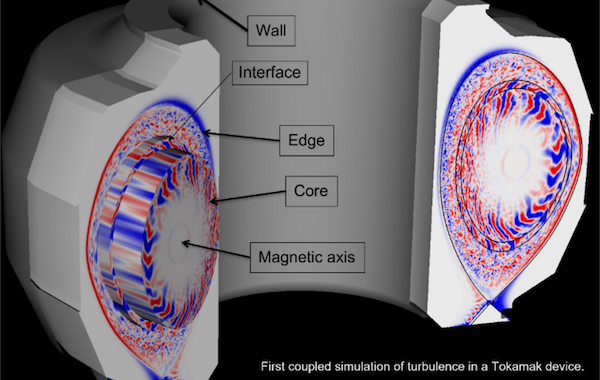The development of a whole device model (WDM) for a fusion reactor is critical for the science of magnetically confined fusion plasmas. In the next decade, the ITER fusion reactor project will realize plasmas well beyond the physics regimes accessible in any previous experiments.[1] Computer simulation offers the ability to gain insight into these regimes as ITER is being built and tested, first with deuterium-deuterium fuel by 2025–2026 and then adapted to perform higher power deuterium-tritium experiments by 2035.[2] The US Department of Energy (DOE) has identified WDM as a high-priority need for “assessments of reactor performance in order to minimize risk and qualify operating scenarios for next-step burning plasma experiments.”[3] This need is reflected in the WDMApp documentation overview, which states, “The Whole Device Model Application (WDMApp) in the DOE Exascale Computing Project (ECP) is developing a high-fidelity model of magnetically confined fusion plasmas, urgently needed to plan experiments on ITER and optimize the design of next-step fusion facilities.”[4]
Technical Introduction
The creation of a WDM planning and optimization tool for controlled fusion in a tokamak fusion device is ambitious. The path chosen by the WDMApp team is to create a first-principles coupled kinetic code for the whole plasma (including core and boundary) and demonstrate an extensible software integration framework for plasma codes that can run well on exascale supercomputers. Challenge problems are chosen to ensure that the software is performant and accurately models the tokamak physics.
In addressing their first challenge problem to test their modeling capabilities, the team used their extendable framework, called EFFIS 2.0, to combine – in a physically accurate manner – simulated results from the XGC gyrokinetic code (used to simulate the edge region of a tokamak) with the GENE or GEM gyrokinetic code (used to simulate the core region). The team has successfully ported to GPU all three codes used in the simulation.
This resulted in the first core-edge coupled simulation of turbulence in the plasma of a tokamak device. The following illustration shows the complexity of the simulated turbulence, along with key parts of a tokamak.[5]

Seamlessly merging the results of these core and edge simulation codes to accurately model the behavior of the plasma required, among other things, mathematically matching the turbulence in physical time and the spatially overlapping regions between the two codes and other essential activities. To address the performance-critical data transfer between the codes, the team used the ECP ADIOS framework.
The following images demonstrate the turbulence modeling capabilities of the separate GENE and XGC codes and the complexity of the simulated results. The animation illustrates how the core evolves more slowly than the edge.

A detailed discussion of the science and computational work performed to seamlessly merge these codes is presented in a paper entitled The Exascale Framework for High Fidelity coupled Simulations (EFFIS): Enabling whole device modeling in fusion science.
Scott Gibson, ECP Communications Specialist, hosts an informative high-level podcast, Let’s Talk Exascale Code Development: WDMApp — XGC, GENE, GEM, with subject-matter experts Tim Williams of Argonne National Laboratory (ANL), Aaron Scheinberg of Jubilee Development, Kai Germaschewski of the University of New Hampshire, and Bryce Allen of ANL and the University of Chicago.
To read the rest of Rob Farber’s Exascale Computing Project technical highlight, visit this link.





























































